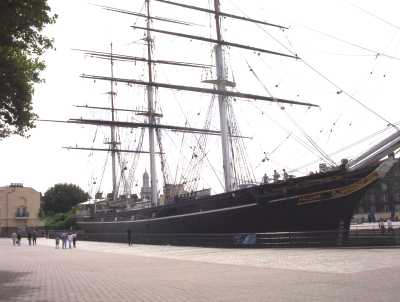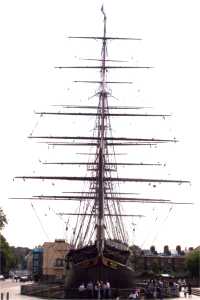Greenwich London Cutty Sark Greenwich England
This wooden ship is one of the main tourist attractions in Greenwich, London, England. |
The Cutty Sark is a Clipper Ship. It is definitely worth a look while you visit London and a few photo's for the holiday album. Over 15 million people have had a tour which has included this wonderful old ship. It makes a memorable trip for the family. |
A devastating fire, in May 2007 has meant the ship is in need of some urgent repairs. The intent is to restore it fully. The projected date for completion was not available at the time of this publication. |
The Cutty Sark
This fabulous ship is well into its retirement. It still stands proud as a popular tourist attraction in Greenwich, London.
This fate is much better than her predecessors and contemporaries. She is second in the hearts of British seamen, only after Nelson's HMS Victory. The site and ship's number of visitors has easily exceeded 15 million people.
Her purpose was to carry tea from China. During her years employed in the tea trade, the Cutty Sark would prove to be exceptionally fast.
Clipper Ships - Description and History
The Cutty Sark is a clipper ship. These are fast, slender sailing vessels developed in the USA in the mid-1800's. A clipper has a narrow hull that was deeper in the back than at the front. It has many large sails mounted on tall masts. The term "Clipper" came from the way the ships "clipped off" - made short work of - the miles. They would be used both for trade and passengers. The Rainbow, designed by John W. Griffiths and launched in 1845, was the first true clipper ship.
 |
Architecture
The Cutty Sark was one of the fastest sailing ships ever built. It measured 212' (64.5m) in length and 36' (11m) in width. It had a sail area of 32,292 square feet (3,000 square m). It could reach speeds of up to 19 miles (31 km) per hour, or 17 knots.
Launched for a Purpose
The Cutty Sark was launched on a Monday, November 22nd 1869. It was built for John 'Jock' Willis. He was dissatisfied by his current ships. He wanted a vessel that was capable of better performance standards. John Willis had a desire to break the speed record in the annual race, bringing home the first of the new season's tea from China.Cutty Sark's Design
Hercules Linton designed it. He molded the bowline of Willis' earlier vessel, The Tweed. He put this into the mid ship attributes of Firth of Forth fishing boats. The result was a new hull shape that was stronger, took more sail and could be driven harder.
Unfortunately, it's soon to be owner drove the designer's company into bankruptcy prior to its completion. Denny & Brothers finally finished it.
The First Suez Crisis
Fate struck again as the French opened the Suez Canal the year she was completed. Her first voyage was to China on a tea run. She left London on this journey, 16th February 1870. Her hopes of glory would appear to have been thwarted at her birth, because the Suez Canal was not available to clippers.
The New Technology of Steam Ships Ruled the Waves
Steamer ships, were able to use Suez. These could now reach the Far East via the Mediterranean. The Cutty Sark's freights fell. The tea trade was no longer profitable for the company that owned her. Her last tea cargo was in 1877.
Sold and Renamed
Fate smiled when the wool trade began in Australia in 1885. She was to be used to her fullest capacity again. But, by 1895, her fortunes plummeted again. This time, because she was no longer profitable, she was sold to a Portuguese group. They renamed her Ferreira. She remained in this company for almost three decades moving between Portugal's colonies.
During wartime there was a shortage of timber. Her dismasting in 1916 obliged her owners to re-rig her as a "barquentine" which carried less sail. She was sold to another Portuguese group in 1920 and renamed again asMaria do Amparo.
Purchased by the British and Restored
The ship arrived in London's Surrey docks for repairs. Here, she was recognized and purchased by a British captain for over 3700 British Pounds in 1922. Renamed a final time as Cutty Sark, she was restored and re-rigged to her original specification. Upon the owners death in 1938, his widow gave the ship to the Thames Nautical Training College at Greenhithe. She remained there until after the Second World War.
The Royal Family Rescues the Cutty SarkFollowing discussions of her fate, she was towed to Greenwich for the festival of Britain in 1951. After this, HRH Duke of Edinburgh formed the Cutty Sark society. She was moved into a specially built dry dock at Greenwich, where she still stands today. Queen Elizabeth II officially opened her to the public in 1957. |
 |
More information about the Cutty Sark
